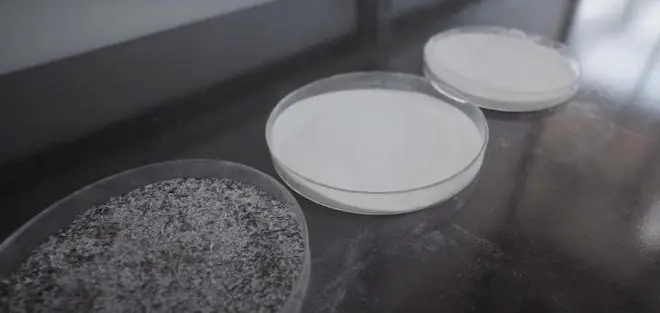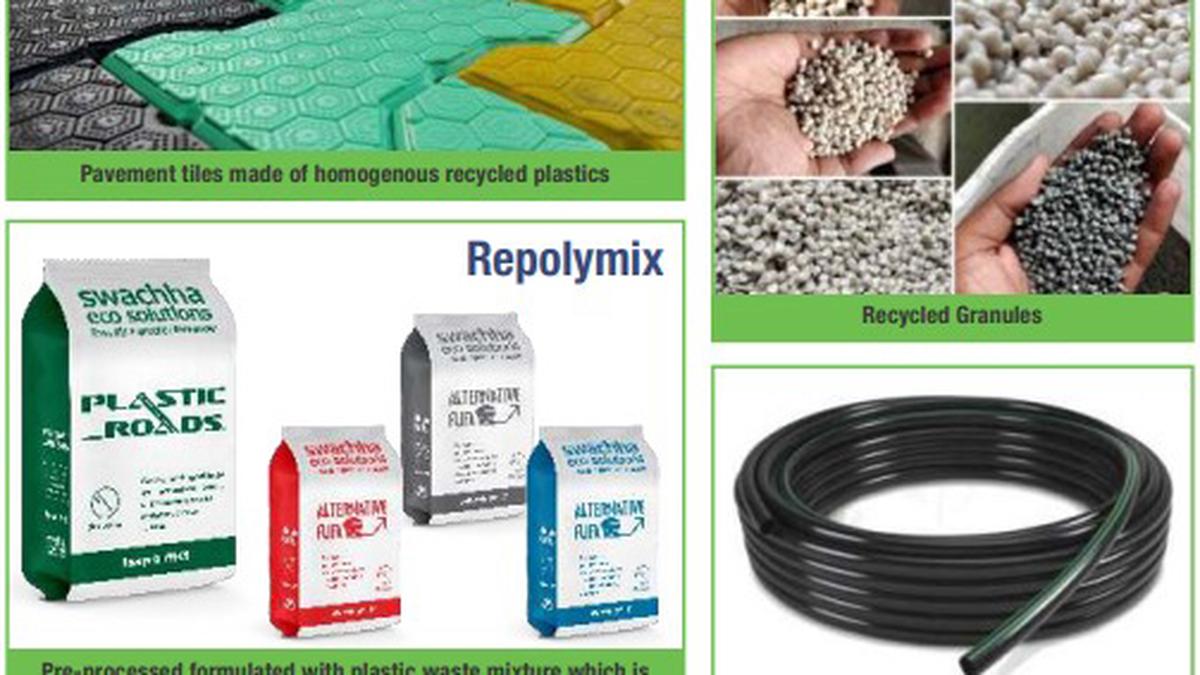
Re-Tile and Re-Polymix manufactured by Swachha Eco Solutions using multi-layered plastic waste
A new category of products have arrived in the market, but few have noticed them. These are solutions thrown up by the circular economy. Leading the charge in developing them are several startups, which are innovating ways to strengthen our nascent recycling system.
Some patented and others awaiting patents, these products have the potential to help us throw away less, use stuff for longer, and lessen the load on burgeoning landfills — be it plastic waste, agri waste, or e-waste.
Green building blocks
Bengaluru-based Victoria Joslin D’Souza, co-founder and Managing Director of Swachha Eco Solutions, has developed two innovative products — Re-Tile and Re-Polymix — derived from multi-layered plastic (MLP), which finds no takers and is the most difficult to collect.

Biosilica produced from rice husk and rice straw ash by Brisil
Partnering with the Bruhat Bengaluru Mahanagara Palike Dry Waste Collection Centre at Attur, she has turned waste plastic into tiles, which she has christened ‘Re-Tile’. D’Souza explains that it takes 15 disposable containers, or 150 polythene bags or disposable spoons, or 10-15 cosmetic bottles to make one piece of these interlocking tiles.
The product awaits a patent, but several designers and architects in Bengaluru are using them, she says. The tiles have resistance up to 150 degrees Celsius, are fire-retardant, anti-slip, and can bear heavy loads.
Re-Polymix, again, is made from recycled plastic and is used in building roads. Mixed with asphalt, it is said to enhance road performance and durability, as validated by the highway technology institute Resource Centre for Asphalt and Soil Training Academy (Rasta) and the Central Institute of Petrochemicals Engineering & Technology (CIPET). According to D’Souza, the environmental impact of Re-Polymix per 1,000 tonnes of asphalt includes plastic diversion of 3–10 tonnes, saving of 60-100 tonnes of virgin bitumen, saving of 1.8 tonnes of carbon dioxide, and energy saving of up to 60 per cent when compared to virgin plastic production.
Ash to new life
While plastic waste and recycled plastic granules show great potential for being transformed into useful products, agricultural waste is not far behind. Startups Brisil and Cancrie, which received grants recently from venture philanthropy platform ACT, transform agri waste into innovative patented green products.

Nano-carbons produced by Cancrie from coconut shells, kernels, sugarcane bagasse, and hair waste
Brisil, the brainchild of Tanmay Pandya, produces bio-silica from rice husk and rice straw ash. Companies that generate energy from rice husk struggle to dispose of the ash waste, which is typically dumped on an open ground or at a landfill. But IITian Pandya, whose unit is based in Vadodara, uses his patented chemical technology to produce bio-silica, which finds extensive use in several manufacturing industries including tyres, footwear, toothpaste, and pharmaceuticals. “In India around 30 lakh tonnes of husk ash is generated annually,” estimates Pandya, whose venture is currently consuming 10,000 tonnes and targets 50,000 tonnes by 2027.
Brisil’s bio-silica can additionally help prevent the indiscriminate mining of riverbeds for silica by the sand mafia.
Jaipur-based Cancrie, co-founded by Dr Akshay Jain and Mahi Singh, uses coconut shells, kernels, sugarcane bagasse, and even hair waste to produce high-value nano-carbons, which find use in lead acid and lithium ion batteries, and capacitors.
“Using an energy-efficient patented process, Cancrie transforms waste into nano-carbons optimised for five key parameters: surface area, pore volume, structure, conductivity, and functionality,” explains CEO Jain.
These improvements result in enhanced electrolyte flow and higher battery performance, thereby reducing the frequency of battery replacement and lowering the demand for valuable mined resources such as lithium, cobalt, and nickel. “Cancrie’s high-purity nano-materials are produced through an energy-efficient process,” says COO Singh.
Currently, field trials and some pilot projects are on to take forward the company’s circular economy mission.
More Like This
Published on June 8, 2025
Anurag Dhole is a seasoned journalist and content writer with a passion for delivering timely, accurate, and engaging stories. With over 8 years of experience in digital media, she covers a wide range of topics—from breaking news and politics to business insights and cultural trends. Jane's writing style blends clarity with depth, aiming to inform and inspire readers in a fast-paced media landscape. When she’s not chasing stories, she’s likely reading investigative features or exploring local cafés for her next writing spot.






